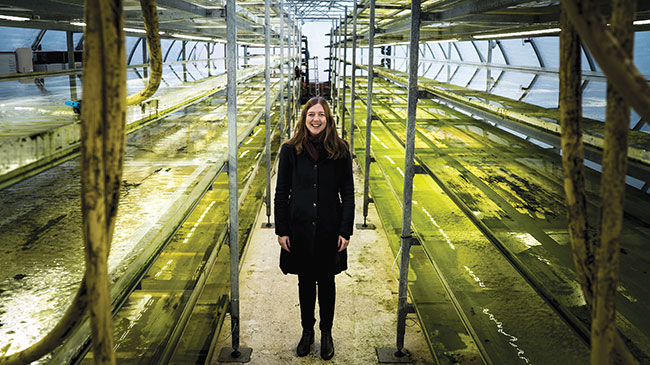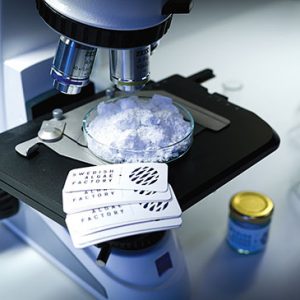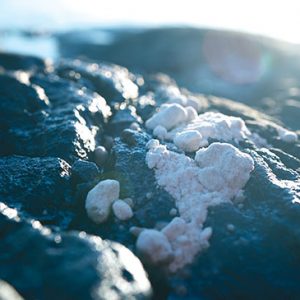
Features
Business Management
Sustainability
Technology
From sludge to solar: One innovative start-up is converting RAS effluent into industrial raw material
Q&A with Sofie Allert, co-founder and CEO of Swedish Algae Factory
August 28, 2020 By Liza Mayer
 Co-founder and CEO of Swedish Algae Factory Sofie Allert at the company's algae-growing facility
Co-founder and CEO of Swedish Algae Factory Sofie Allert at the company's algae-growing facility Much has been said about the role of fisheries and aquaculture in the fight against hunger and poverty. However, little is known about its role in helping advance environmental sustainability through use of aquaculture by-products and fish processing waste – and with good reason.
After all, roughly 88 percent of the world’s fish production is used for direct human consumption while only 12 percent is used for non-food purposes, according to the Food and Agriculture Organization.
In this Q&A, we digress a bit from food fish and take a look at the industry’s new and exciting contributions to other industries. Sofie Allert, co-founder and CEO of Swedish Algae Factory (SAF), shares her company’s perspective as a Norwegian startup backed by aquaculture investment firm AquaSpark.
According to the Netherlands-based impact investor, SAF has developed the first economically-viable facility to grow high-value algae on RAS effluents. “Swedish Algae Factory offers an affordable, sustainable solution for farmers. Through its circular model, the algae cleans wastewater, absorbs carbon dioxide, and also creates nutrient-rich organic biomass that can be used for fish feed or fertiliser,” it said.
Hatchery International: What does Swedish Algae Factory do and why is this work important?
Sofie Allert: Swedish Algae Factory wants to prove that it is possible to create an industry that is climate positive and thereby, does not endanger the environment and human health. This is important if we ever want to create a truly sustainable industry. We accomplish this with the help of algae, where our algae is used to produce a nanoporous high-tech material (Algica), Omega-3 fatty acids and a nutrient-rich biomass that can be used to, for example, make fish feed more sustainable.
HI: In layman’s language, can you explain what Algica is and its uses?
SA: Algica is the unique porous silica (glass) shell of the microscopic algal group called diatoms. The porous structure is so unique that we humans cannot synthesize it. This structure has advanced light-manipulating, absorbing and releasing properties, which makes it interesting in a wide range of applications. Today, Algica is sold to the personal care industry and is tested with actors in the solar industry, with positive results.
HI: What market need did you see that led you to produce this product?
SA: We started out with commercialization in the solar industry where we saw the need for a material like ours to be able to further enhance the efficiency of solar panels. The solar industry, though, needs large volumes before commercialization, which we do not yet have. By coincidence, we were contacted by a personal care actor that saw the potential of adding Algica in their products to make them more environmentally-friendly and ocean-safe. Now we are really happy to be able to contribute to making personal care products more sustainable.
HI: What makes RAS effluent ideal as a growing medium for Algica?
SA: To make the production process as environmentally-friendly as possible, we clean wastewater from excess nutrients instead of using virgin nutrients that often are produced in unsustainable ways. By doing this, we make use of nutrients that otherwise might have been released to the sea or lakes, increasing harmful algal blooms.
For a marine ecologist, it was natural to use RAS effluent as it is ideal for growing algae. It basically mimics the natural environment where algae and fish are living in symbiosis. Fish are producing carbon dioxide and nutrients for algal growth and in turn the algae provide oxygen, valuable nutrients and Omega-3 fatty acids for the fish.
HI: How does a fish farmer benefit from your use of effluent water for the RAS farm?
SA: Their cost of wastewater treatment is lowered and the wastewater treatment becomes more stable. Algae is used as the first wastewater treatment step and are thereby producing oxygen to the following bacteria step, as well as for the fish. By using algae in the wastewater treatment, the nutrients are also put to better use where the organic biomass of the algae can be used to feed the fish more sustainably.
The fish farm is mainly a supplier of nutrients and we are a wastewater treatment service to them, as well as a potential fish feed ingredient supplier. For this to work in an optimal way, a close collaboration is crucial. In that way, a win-win both from an environmental and financial standpoint can be maximized.
- Algica, a high-tech material from algae, replaces harmful and less efficient chemicals in solar panels.
- Algica, as found in nature. Swedish Algae Factory is producing the material from algae grown on RAS effluents
HI: Are you on commercial production now?
SA: We are now at a small commercial-scale production (pilot) and are in the process of scaling up in order to enable sales to the solar industry and larger actors in the personal care industry. We foresee several more applications of our Algica.
HI: Do you see aquaculture having a bigger role in your efforts?
SA: We would be happy to build a business model when scaling up around collaborations with fish farms, both using seawater and lake water. Until now, we do not see any uses of Algica in seafood farming. The by-product from extracting Algica, the organic biomass, however, could be used as a feed ingredient in all kinds of seafood farming not the least since microalgae being the very origin of omega-3 fatty acids.
HI: What are your priorities over the next two to three years?
SA: Scaling. By the end of 2021, we aim to have our first larger facility up and running, together with a land-based fish farm. From then on, we would like to spread our idea globally and have an impact, making RAS and circular economy the mindset for sustainability.
Print this page
Advertisement
- High-dose micronutrients promote skin health in European sea bass: study
- Philippines farmers turning to DIY feed for savings potential







